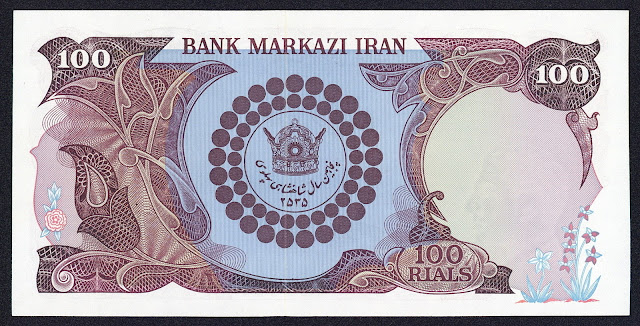Iran 100 Rials Commemorative Banknote 1976 50th Anniversary of Pahlavi Dynasty
Banknotes of Shah Mohammad Reza Pahlavi era
Bank Markazi Iran - Central Bank of Iran
Iranian banknotes, Iranian paper money, Iranian bank notes, Iran banknotes, Iran paper money, Iran bank notes.
A 100 Rials banknote, commemorating the Pahlavi jubilee in 1976. This issue is released only in one denomination and it's a unique banknote in the history of paper money in Iran as it holds the portrait of two shahs from the Pahlavi dynasty on the front side: Shah Mohammad Reza Pahlavi & his crowned father Reza Shah Pahlavi. The general appearance of the banknote is the same as its definite series except for the portrait of the shahs and the old building of the National Bank of Iran on the front side and the emblem at the back.In 1976, reference of the calendar was changed to the Imperial years and the Hejri years were not used any more. In the middle of the emblem of the Pahlavi jubilee the Imperial year of 2535 (1976) is placed.
Obverse: Busts of Mohammad Reza Shah Pahlavi & Reza Shah Pahlavi on the right. The building of the National Bank of Iran is noted below the signatures, although the banknote is published by the Central bank of Iran.
Scripts: above: Bank-e- Markazi-e- Iran (Central bank of Iran); Sad Rial (One hundred Rials).
Signatures: Right: Minister of wealth affairs: Hooshang Ansaari. Left: General director: Hasanali Mehran.
Reverse: Two Rings of 50 Concentric Circles around Pahlavi Crown - Emblem of the 50th anniversary of Pahlavi reign. Script: Panjahomin saal-e- Shahanshahi-e- Pahlavi, 2535 ( The 50th year of Pahlavi reign, 1976).
Watermark: Young Mohammad Reza Shah Pahlavi in profile.
Printer: Thomas De La Rue & Company, Limited.
Dimensions: 130 × 67 mm.
Pahlavi dynasty
The Pahlavi dynasty was the ruling house of Iran from 1925 until 1979, when the monarchy was overthrown and abolished as a result of the Iranian Revolution. The dynasty was founded by Reza Shah Pahlavi in 1925, a former Brigadier-General of the Persian Cossack Brigade, whose reign lasted until 1941 when he was forced to abdicate by the Allies after the Anglo-Soviet invasion. He was succeeded by his son, Mohammad Reza Shah Pahlavi, the last Shah of Iran.
The Pahlavis came to power after Ahmad Shah Qajar, the last ruler of the Qajar dynasty, proved unable to stop British and Soviet encroachment on Iranian sovereignty, had his position extremely weakened by a military coup, and was removed from power by the parliament while in France. The National Assembly, known as the Majlis, convening as a Constituent Assembly on 12 December 1925, deposed the young Ahmad Shah Qajar, and declared Reza Shah the new monarch of the Imperial State of Persia. In 1935, Reza Shah asked foreign delegates to use the term Iran, the historical name of the country, used by its native people, in formal correspondence and the official name Imperial State of Iran was adopted.
Faced with growing public discontent and popular rebellion throughout 1978, Mohammad Reza Shah Pahlavi went into exile with his family in January 1979, sparking a series of events that quickly led to the dissolution of the state on 11 February 1979, officially ending the 2,500-year-old tradition of monarchy in Iran. At the death of Mohammad Reza Shah Pahlavi on 27 July 1980, his son Reza Pahlavi became the head of the Pahlavi royal family.
Pahlavi Crown
The Pahlavi Crown is part of the coronation regalia used by the Pahlavi Shahanshahs of Iran (Persia) and is part of the Iranian Crown Jewels.
Following the ascension of the Pahlavi Dynasty in 1925, Reza Shah ordered a group of Iranian jewelers, under the supervision of Haj Serajeddin Javaheri, to create a new crown to replace the Kiani Crown which had been used by the Qajar dynasty. Inspiration for the new design was drawn from paintings and historical references to crowns used during the Sassanid Empire, which had ruled Persia from 224 to 651 AD.
The Pahlavi Crown was commissioned and first used for the coronation of Reza Shah on 25 April 1926. It was used for the last time during the coronation of his son and successor Mohammad Reza Shah Pahlavi on 26 October 1967. The crown is currently on display with the rest of the Iranian Crown Jewels at the Central Bank of Iran in Tehran.
Although the Pahlavi Crown was not assembled until the early 20th century the stones used in its production, as per tradition, were selected from the thousands of loose stones already in the Iranian Imperial Treasury.
Composition
The frame of the crown is made of gold, silver and red velvet. It has a maximum height of 29.8 cm, a width of 19.8 cm and weighs nearly 2,080 grams. A staggering 3,380 diamonds, totaling 1,144 carats (228.8 g), are set into the object. The largest of these is a 60-carat (12 g) yellow brilliant which is centrally placed in a sunburst of white diamonds.
Found in three rows are 369 nearly identical natural white pearls. The crown also contains five sizable emeralds (totaling 200 carats (40 g)), the largest of which is approximately 100 carats (20 g) and located on the apex of the crown.

